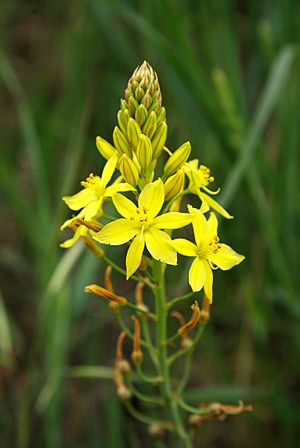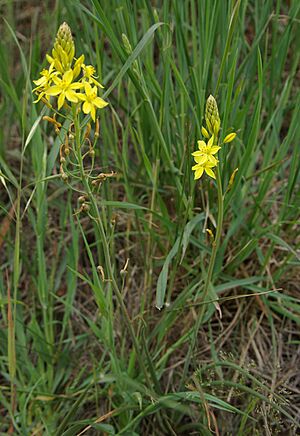Bulbine lily facts for kids
Quick facts for kids Bulbine lily |
|
|---|---|
 |
|
| Scientific classification | |
| Synonyms | |
|
Anthericum bulbosum R.Br. |
The Bulbine lily (scientific name: Bulbine bulbosa) is a pretty flowering plant that grows only in Australia. It's often called the golden lily or native leek. But don't let the names fool you! Even though it sounds like a lily or an onion, it's actually not related to them at all. It belongs to its own special group of plants called Bulbine.
Contents
What it Looks Like
The Bulbine lily often grows in big groups. It can grow quite tall, up to 75 centimeters (about 2.5 feet). Its leaves are a grayish-green color and are long and narrow, like a spearhead. They are also succulent, which means they are thick and can store water.
This plant has lovely, star-shaped yellow flowers that smell nice. These flowers grow on tall stems. The oldest flowers are usually found at the bottom of the stem. Each flower has six petal-like parts called tepals. They also have fuzzy, yellow parts that look like tiny brushes.
Even though each flower only lasts for one day, the whole plant can keep blooming for several weeks! The Bulbine lily usually flowers from September to March. When winter comes, the plant forms a round, underground storage part called a corm. This corm helps the plant survive until spring.
Where it Grows
The Bulbine lily is found only in the eastern half of Australia. You can see it in places like Queensland, New South Wales, Victoria, eastern South Australia, and Tasmania.
It can grow in many different places, or habitats. These include dry forests, open fields, rocky cliffs, and even wet areas like swamps. It likes places that get rain in winter.
How People Use It
The underground corms of the Bulbine lily are full of good nutrients like calcium and iron. Long ago, Aboriginal people ate these corms. They called them parm, puewan, or pike. They thought these corms were the sweetest-tasting of all the lily-like plants in Australia.
Is it Safe to Eat?
While people can eat the corms, it's said that if sheep or cattle eat this plant, it can make them sick.
Growing it in Gardens
People sometimes grow Bulbine lilies in their gardens. They are popular because their yellow flowers are pretty and last a long time. Also, they can handle a bit of frost.
You can grow new plants from seeds or by dividing the corm. It's best to plant the seeds in the spring. They usually sprout in about 35 days. These plants need good watering, but also soil that drains well so they don't get too wet.
If you collect seeds from plants in your garden, you might find that not many of them grow. This is because the plant tries to avoid fertilizing itself. Planting seeds from different sources can help more of them grow.

See also
 In Spanish: Bulbine bulbosa para niños
In Spanish: Bulbine bulbosa para niños

